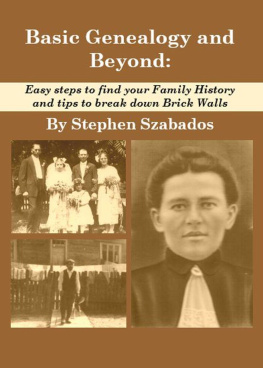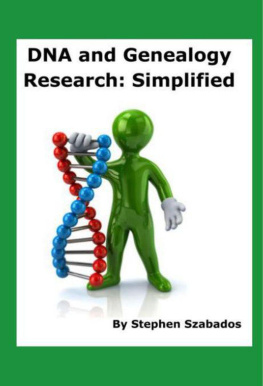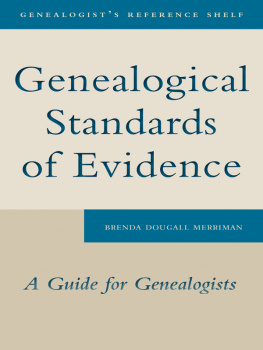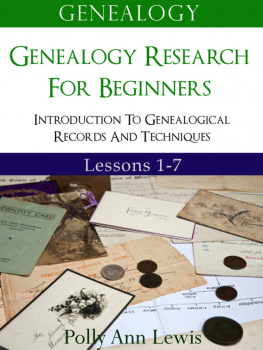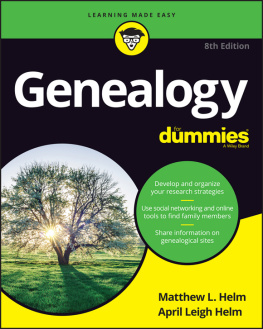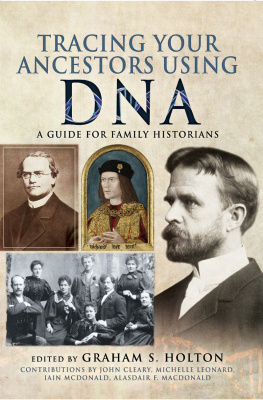SOME FAMILY
Some Family
THE MORMONS AND HOW HUMANITY KEEPS TRACK OF ITSELF
DONALD HARMAN AKENSON

Donald Harman Akenson 2007
ISBN 978-0-7735-3295-3
Legal deposit third quarter 2007
Bibliothque nationale du Qubec
Printed in Canada on acid-free paper that is 100% ancient forest free (100% post-consumer recycled), processed chlorine free.
McGill-Queens University Press acknowledges the support of the Canada Council for the Arts for our publishing program. We also acknowledge the financial support of the Government of Canada through the Book Publishing Industry Development Program (BPIDP) for our publishing activities.
Library and Archives Canada Cataloguing in Publication
Akenson, Donald Harman, 1941
Some family: the Mormons and how humanity keeps track of itself / Donald Harman Akenson.
Includes bibliographical references and index.
ISBN 978-0-7735-3295-3
1. Genealogy. 2. Church of Jesus Christ of Latter-Day Saints. Family History Library History. I. Title.
CS14.A38 2007 929.1 C2007-903804-2
This book was typeset by Interscript in 10.5/13 Baskerville.
For Citizen Harcourt
Contents
Figures and Tables
FIGURES
TABLES
SOME FAMILY
Prologue
(a time-gamblers tip sheet)
1 Perhaps flip a coin, this is a 50/50 proposition by 2050 most people on this planet will learn of their familial history and how it fits into the pattern of world history from information provided by the Church of Jesus Christ of Latter-day Saints (the Mormons).
2 Very probably you can bet your farm on this by 2025 more human beings will learn their family histories and how world history has evolved through the Mormons data and theologic-history than from any other source. Try to find a compulsive gambler with deep pockets.
3 And absolutely certainly at the present time the largest pool of information on specific, identifiable individuals who have comprised the human race has been assembled by the Latter-day Saints. Bigger than any governmental data pool ever will be. The standard release form that the LDS asks owners of family histories and other data bases to sign explains that, this is so the data from your materials can be used to create a common pedigree of mankind. Immodest, hubristic, monumental, heroic, and in many ways engagingly humble, for it is all in the service of recreating the divine chain of being, from God to humanity.
Before you place your bets, how, why and how well this project is proceeding might be worth considering.
PART ONE
Getting in Touch
1 Yesterdays News
Genealogical workers of the world, unite! Karl Marx might have urged, had he lived a century later than he did. And he would have heard the reply, why bother? The Mormons are busy doing everything already.
That situation takes some explaining and, more importantly, evaluating. Whether one thinks of the members of the Church of Jesus Christ of Latter-day Saints as the advancing proletariat of the ultimate theological revolution or as affrighted creatures, clinging like limpets on a battered seashore, they are a massive, if usually underestimated, cultural force. Their present goal (among other faith-driven objectives) is to create an accurate and comprehensive genealogical tree of the entire human race: or, to put it another way, to establish, piece by piece, soul by soul, the narrative of humankind since the beginning of civilization. They intend to create the master narrative into which each one of us fits.
That these outwardly modest people are silently driven by a hubris that is well beyond that of the most megalomaniacal of world imperializers (even Alexander of Macedon set out to conquer only the peoples of the world he lived in, not the entire past of humanity), and that they are so irritatingly nice and vexingly and smilingly optimistic in their work, makes them, at minimum, something special.
The Church of Jesus Christ of Latter-day Saints (usually called the Mormons by outsiders in reference to one of the churchs holy books: a reference LDS members accept as a convenient shorthand and often use themselves) claims to have roughly 1214 million adherents. Somewhat fewer than half of these are found in North America.
The dimensions of the collective project they are working on are so big that it is hard to comprehend, much less grapple with. You can acquire a sense of its potential size by sitting down with a calculator and doing the simple math: start with yourself as the (imaginary) only soul on the planet and assume that a human generation over time has averaged twenty-five years and that, for the sake of simplicity, there has been no inbreeding and that there has been only one child per family in each generation (and, of course, two parents in each preceding generation). Even by these severely limiting assumptions, by the time Christopher Columbus blundered into the New World, you are the product of 1,048,576 ancestors. So, if you are interested in your own lineage, there is a bit of genealogical digging for you to do. And, if you were to be ambitious and take things back to the time of Jesus of Nazareth, the number of people you were seeking as ancestors would, in conventional numerical notation, stretch all the way across the page. (Think of the number 6 with twenty-three zeros after it and you will be close enough.)
Of course matters are a bit more complicated than that. You are not the only person on earth and, obviously, our assumption of one child per family per generation is a simplification that is way out of touch with reality. (The world records for fecundity are the more than 1,400 progeny sired by Moulay Ismail, an eighteenth-century emperor of Morocco, and on the female side, the 69 children of Fedora Vassilyev, an eighteenth-century Russian woman.) Thus, if the Mormons are going to make a world pedigree, it would seem they have their work cut out for them.
What saves their task from being completely inconceivable is the simple fact that human beings interbreed quite promiscuously. Not just third cousins, or second, but first cousins, uncles and nieces, brothers and sisters, fathers and daughters, nephews and aunts, wives and brothers-in-law, and on and on. Most of the closest inbreedings are covered up by social convention and by skilled lying. Unless your parents come from totally separate populations (say, from Africa and from China), you would not have to go back many generations to find some of your mothers people procreating with your fathers would not, that is, if the records were complete and accurate, which they are not. And, in any case, your mothers people were procreating with each other, as were your fathers: the only question is how genetically close the inbreeders were.
Whether or not one likes this basic fact of frequent human inbreeding, it provides a valuable set of advantages for genealogists and geneticists. It means, first, that any individual will have a lot fewer distinct genealogical lines to trace than if there had been no inbreeding. This is because an individuals several genealogical lines intersect with each other multiple times in any long genealogical chain. And, secondly, for genealogists (like the Mormons) who are devoted to tracing large groups of people, it means that individual persons in one genealogical line will also be more frequently found in the genealogical lines of other persons than if there had been no in-breeding. The limited original population from which we all stem means that we are all interrelated; and, if there were a full genealogy of every human being, we would discover that not only are we all related, but that our ancestors intersected each other several times in a great genetic tangle. This may be messy, but it permits the multiple usage of a single cell of data: information on your twenty-third grandfather will probably fit into the family tree of several score of people, though none of you will be known to each other.
Next page

